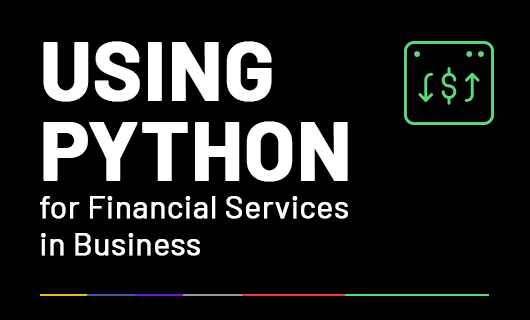Only a few other languages can match Python for its versatility. Web development, machine learning, automation, scientific computing, and even gaming – Python can do all this and then some. But it’s data analytics that is often considered the most prominent and widespread application of this general-purpose programming language. Python has a lot to offer to professionals working in the field of data analysis and usually is their first and only choice. But what makes this language a good fit for data scientists? Read on to learn why many businesses run their data analytics with Python.
How is Python Used in Data Analysis
There are several ways in which data analysis in Python is performed. Depending on the project’s scope and complexity, Python development services experts can utilize Python for the following:
- Data Manipulation – cleaning, filtering, and merging data sets.
- Data Visualization – creating various types of charts, graphs, and plots.
- Statistical Analysis – hypothesis testing, regression analysis, and time series analysis.
- Machine Learning – building and training machine learning models for classification, regression, and clustering tasks.
- Big Data Processing – analyzing and processing large data structures.
Advantages of Business Data Analysis with Python
Why do companies specializing in back-end development services prefer building solutions for data analytics with Python? The language offers several advantages that make it stand out from the rest of the technologies (such as R, MATLAB, and Julia) used by data science experts:
- Easy to Learn for Data Analysts and Developers
- Large and Active Community of Users and Developers
- An Extensive Library of Modules and Packages for Data Analytics in Python
- Python is Highly Scalable and Can be Used to Handle Large Amounts of Data
- Python can be Easily Integrated with Other Tools and Technologies
In the following paragraphs, we will look at these advantages separately.
Easy to Learn for Data Analysts and Developers
Python is an excellent choice for any data analyst or data engineer starting in the industry. The syntax of Python is straightforward to read, making it an ideal language for beginners with modest programming skills. This simplicity allows data analysts to get up and running with Python quickly and easily without spending months learning a new language. The developers also benefit greatly from Python’s simplicity, as they can write code more efficiently, which saves time and resources.
Large and Active Community of Users and Developers
A vast and active community of users and developers constantly contributes to developing new tools, libraries, and resources for data analytics in Python. Known for its helpful attitude, Python’s community provides a wealth of information and support for both inexperienced and seasoned users. It also helps to ensure that Python remains a relevant and powerful language for data analysis.
An Extensive Library of Modules and Packages for Data Analytics in Python
One of Python’s key benefits is its enormous library of modules and packages that offers pre-built functionality for data analysis tasks. Python libraries can help users understand data distribution, analyze and clean data, handle missing values, add interactive visualizations, etc. For example, the NumPy library performs mathematical operations on arrays. The pandas library can be employed to import and access data from multiple sources, manipulate any data frame, or create a box plot with all the variables for exploratory data analysis. These libraries make data analytics in Python faster and more efficient by providing a wide range of functions that can be used to perform complex data analysis tasks.
Python is Highly Scalable and Can be Used to Handle Large Amounts of Data
Python can handle massive amounts of data, making it an ideal solution for processing and analyzing big datasets. Its scalability comes from integrating with other technologies such as Hadoop, Spark, and NoSQL databases. This allows Python to work with large databases and distributed computing systems, making it a popular choice for big data analytics.
Python can be Easily Integrated with Other Tools and Technologies
Making Python work with other tools and technologies isn’t particularly challenging. It can be integrated, for instance, with SQL databases to access and analyze data or with visualization tools such as Matplotlib or Seaborn library for creating visual representations of data. Vast integration capabilities with other tools and technologies make data analysis with Python a much more straightforward and streamlined experience.

Key Features of Python That Make It the Most Popular Programming Language
Python’s enormous popularity isn’t limited only to the data science community. With a multitude of in-built features and countless libraries, Python is almost always considered a leading technology in varied projects. Top companies and global organizations, like NASA, IBM, Netflix, and Facebook, utilize Python in different areas of their operations. Let’s see why.
Easy to Read and Write
One of the primary reasons for Python’s popularity is its ease of readability and writing. Python follows a clean and straightforward syntax, making it highly readable and understandable even for beginners. The language emphasizes code readability through meaningful indentation and a minimalist approach to coding. This feature allows programmers to write more in fewer lines, making their code concise and maintainable, enhancing collaboration, and reducing the chances of errors.
Python Supports Dynamic Typing
Python’s support for dynamic typing is another key feature that sets it apart from many other programming languages. In Python, developers do not need to explicitly declare the variables, as the language dynamically infers the variable type at runtime. This dynamic typing feature allows for more flexibility and productivity, enabling programmers to write code more quickly without worrying about explicit type declarations. It also facilitates the creation of dynamic data structures and simplifies code maintenance and refactoring.
High-Level Language
As a high-level programming language, Python abstracts many low-level operations, such as memory management. It allows programmers to focus more on solving problems rather than dealing with intricate system details. Python’s high-level nature, extensive standard library, and vast ecosystem of third-party packages empower developers to accomplish complex tasks efficiently and rapidly.
Python Can Run on Multiple Platforms
Python’s versatility is evident in its ability to run on different platforms. Its code can be executed on various operating systems, including Windows, macOS, Linux, and more. This allows developers to write code once and run it seamlessly on different systems without requiring extensive modifications. Python’s cross-platform compatibility has made it a go-to choice for developing applications that need to be deployed in different environments or when working in teams with diverse operating system preferences.
Object-Oriented
Python’s support for object-oriented programming (OOP) is another key feature that contributes to its popularity. Python allows developers to create code using classes and objects, promoting modular and reusable code design. Object-oriented programming facilitates code organization, improves its readability, and enables developers to create complex systems by modeling real-world entities. Python’s OOP capabilities and other features like inheritance, polymorphism, and encapsulation provide developers with a powerful toolset to write efficient and maintainable code.
Python is an Open-Source Language
Python’s open-source nature means that its source code is freely available, allowing developers to access, modify, and distribute it without restrictions. This openness has fostered a vibrant and active community of Python enthusiasts, who contribute to its development, create libraries, frameworks, and tools, and provide support through online forums and resources. The open-source ecosystem surrounding the language has played a vital role in elevating Python’s profile to its powerhouse status today.
Popular Libraries for Data Analytics in Python
Python offers a rich ecosystem of libraries and frameworks for data analytics. Let’s investigate the most popular libraries for data analytics in Python.
- Pandas – widely used for data manipulation and analysis, this open-source library provides two data structures (series and data frames), allowing efficient, structured data handling. With pandas, data cleaning, transformation, filtering, and aggregation become much more manageable. It also supports data integration from various sources like Excel and CSV files, SQL databases, and more.
- PyTorch – an open-source machine learning framework that offers a dynamic computational graph approach, making it flexible and efficient for the process of building and training deep learning models. PyTorch is universally used in natural language processing (NLP) and computer vision applications.
- TensorFlow – a popular and comprehensive open-source library for machine learning and deep learning. It provides a flexible ecosystem for building and deploying ML models. TensorFlow’s graph-based execution allows efficient distributed computing across multiple devices. It supports various tasks, including image recognition, natural language processing, and time series analysis.
- Matplotlib – a powerful data visualization library offering extensive plotting options. With the Matplotlib library, you can create any line plot, scatter plot, bar plot, or histogram to show detailed information on chosen dataset. It provides customization options to control the appearance and styling of plots, making it suitable for creating publication-quality visualizations.
- NumPy – also known as Numerical Python, NumPy is an essential library for data analysis with Python. It efficiently handles multi-dimensional arrays and various mathematical functions for array manipulation. NumPy’s vectorization and broadcasting concepts enable fast numerical computations and element-wise operations on arrays.
- Seaborn – this high-level data visualization library has been built on top of Matplotlib. It focuses on creating visually appealing and informative statistical graphics. Seaborn simplifies the process of generating complex plots, such as distribution, regression, and categorical plots. It also provides convenient integration with pandas data structures, making working with any given dataset much easier.
- Scikit-learn – a comprehensive machine learning library that contains diversified tools and algorithms for various tasks, such as classification, regression, clustering, and dimensionality reduction. The scikit-learn library offers a user-friendly API and extensive documentation, making it accessible to both beginners and experienced practitioners. It provides a rich set of features such as model evaluation, hyperparameter tuning, and data preprocessing.
- Statsmodels – designed explicitly for statistical modeling and hypothesis testing, this Python module provides a wide range of statistical models, including linear regression, generalized linear models, and time series analysis. Statsmodels offers a comprehensive set of statistical tests and diagnostic tools for model evaluation and inference. It focuses on providing detailed statistical insights and interpretability, making it suitable for researchers and statisticians.
The Best Applications of Python in Business Data Analysis
- Data manipulation – libraries like pandas or NumPy enable businesses to handle any large dataset, perform data wrangling tasks, and prepare data for analysis.
- Data Visualization – with Matplotlib or Seaborn libraries, businesses can create compelling visualizations of their data to help gain insights, present findings, and effectively communicate data-driven stories.
- Statistical Analysis – Python supports various statistical analysis tasks. Businesses use libraries like SciPy and StatsModels to perform statistical modeling, hypothesis testing, regression analysis, and other techniques to extract insights from their data.
- Machine Learning and Predictive Analytics – Libraries such as scikit-learn and TensorFlow support building and deploying machine learning models. Businesses utilize it to make future predictions, create data-driven forecasts, and automate decision-making processes.
- Natural Language Processing (NLP) – Python’s Natural Language Toolkit (NLTK) offers robust NLP capabilities. With it, businesses can evaluate and process text data, perform sentiment analysis, and automate text-based tasks like document classification and summarization.
- Automation and Workflow Efficiency – Python’s scripting capabilities make it ideal for automating repetitive tasks and streamlining workflows. Businesses can use Python to develop scripts that automate data processing, generate reports, schedule tasks, and integrate different software systems for improved efficiency.
Our Parting Shot
Data analysis in Python is an enormously vast and complex area where all advantages of this language can be utilized to the fullest. Python’s rich ecosystem of libraries and its ease of use make it a powerful tool for various aspects of business data analytics. At Scalo software development company, we recognize the potential and capabilities of data analysis with Python, and we encourage our partners to make the most of it. After all, for businesses that nowadays aim to stay competitive, efficient data-driven decision-making isn’t an option; it’s a must.





